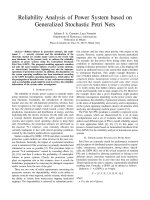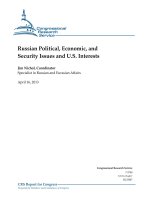Availability and reliability analysis of computer software systems considering maintenance and security issues
Bạn đang xem bản rút gọn của tài liệu. Xem và tải ngay bản đầy đủ của tài liệu tại đây (1.84 MB, 197 trang )
AVAILABILITY AND RELIABILITY ANALYSIS
OF COMPUTER SOFTWARE SYSTEMS
CONSIDERING
MAINTENANCE AND SECURITY ISSUES
XIONG CHENG-JIE
NATIONAL UNIVERSITY OF SINGAPORE
2011
AVAILABILITY AND RELIABILITY ANALYSIS
OF COMPUTER SOFTWARE SYSTEMS
CONSIDERING
MAINTENANCE AND SECURITY ISSUES
XIONG CHENG-JIE
(B. Eng), WUHAN UNIVERSITY
A THESIS SUBMITTED
FOR THE DEGREE OF DOCTOR OF PHILOSOPHY
DEPARTMENT OF INDUSTRIAL AND SYSTEMS
ENGINEERING
NATIIONAL UNIVERSITY OF SINGAPORE
2011
Acknowledgement
First and foremost my greatest gratitude goes to my main supervisor, Prof. Xie Min, who
supported me both in research and in practice all through my PhD candidature and whose
wisdom is so charming that enlightened my research path. He is not only a well-respected
advisor in research, but also more a spiritual tutor as well as a great friend. His knowledge and
patience helped me transform from a beginner to a junior research without anxiety or frustration,
which I am extremely grateful for. What is more, his noble personality and passion for research
always spurs me to search more for research and life. I would have achieved much less if I had
not been under his supervision.
I am also heartily thankful to my co-supervisor, A/Prof. Ng Szu Hui, for her guidance and
very detailed suggestions in my research, especially when I was undergoing the manuscript
reviewing process. Her serious attitude towards research always reminds me to get rid of
fickleness and utilitarianism, which was fatal in research. Her positive life style and friendliness
also made me feel more inspired when I was her teaching assistant. I also gained lots of teaching
experience from her. I am really grateful for her directions.
Then I also want to express my gratefulness to the Department of Industrial and Systems
Engineering and the National University of Singapore, for providing me scholarship and an
II
excellent environment to study and do research. I would have missed the most precious life
experience if I had not won a chance to study in Singapore.
I would like to thank A/Prof. Poh Kim Leng and Dr. NG Tsan Sheng, Adam, for serving
as my oral qualification exam committee and provided me lots of deep insights for my further
research. I also greatly thank Ms. Ow Lai Chun and Mr. Lau Pak Kai, for their excellent
administrative and technical support to my PhD study. The warmest gratefulness also goes to
A/Prof. Tang Loon Ching, who interviewed and encouraged me to join the Department of
Industrial and System Engineering in Shanghai 5 years ago. I would not be able to finish this
thesis, or even to start writing this thesis, without their help.
As a member of the Quality and Reliability Lab, I also benefited a lot from my lab mates.
With all of them, I had a great post-graduate life for 4 years. Special thanks goes to Li Yanfu and
Shen Yan, who helped me a lot in life and at the same time in research, especially in research
proposal and thesis writing. I would also like to thank Qian Yanjun, Yin Jun and Zhou Peng, for
their help and advices that made my life and research easier.
Finally, I would like to express my deepest thank to my parents, for their continuous
encouragements and support for more than 20 years. Furthermore, to Mao Chengting, thank you
for your understanding and encouragements.
I
Table of Contents
Acknowledgement I
Summary IV
List of Tables VII
List of Figures VIII
List of Notations and Acronyms IX
Chapter 1 Introduction 1
1.1 Focus of this thesis 2
1.2 Introduction to Quality Metrics of Computer Software Systems 2
1.2.1 Software Reliability 3
1.2.2 Software Availability 3
1.2.3 Software Service Reliability 4
1.3 External Factors Affecting Software Quality 5
1.3.1 Software Maintenance 5
1.3.2 Malicious Software 6
1.4 Research Motivation 7
1.5 Thesis Organization 8
Chapter 2 Literature Review 10
2.1 Reviews on Software Reliability Modelling 10
2.1.1 Basic Software Reliability Models 10
2.1.2 Software Reliability Model Extensions 22
2.2 Reviews on Software Availability Related Problems 25
2.2.1 Software Maintenance and Software Availability 26
2.2.2 Software Availability Assessment 32
2.2.3 Malicious Software and Its Impact on Software Quality 36
Chapter 3 Software Availability Modelling and Application Extensions 40
3.1 Introduction 40
II
3.2 Software Maintenance Activities and Software Availability 43
3.2.1 Decomposition of Software Maintenance Activities 43
3.2.2 Software Maintenance Efforts and Software Maintenance Modeling 46
3.2.3 Software Maintenance Modeling—A Numerical Example 51
3.2.4 Validation of Software Maintenance Modelling 57
3.2.5 Software Availability Modeling Considering Software Maintenance 58
3.3 Software Maintenance Policy Considering Software Availability Constraints 67
3.3.1 Re-investigation on Software Maintenance and Software Maintenance Policy 67
3.3.2 Software Maintenance Policy Modeling with Consideration of Software Availability and Cost
Constraints 71
3.3.3 Validation of Policy Optimality—A Numerical Example 75
3.4 Summary and Conclusion Remarks 80
Chapter 4 Software Availability Assessment of N-version Programming Systems 82
4.1 Introduction 82
4.2 Software Availability Modeling of N-version Programming Systems 85
4.2.1 Structure Decomposition of N-version Programming Systems 86
4.2.2 Proposed Model of Software Availability of N-version Programming Systems 89
4.3 Impact of N-version Programming on Software Availability 98
4.3.1 Failure and restoration rates for different versions of software 98
4.3.2 Impact of N-version Programming on Software Availability: A Simulation Approach 101
4.3.3 Optimal Software Structure under Software Availability and Budget Constraints 112
Chapter 5 Quality Degradation Analysis of Distributed Software Systems Considering
Malware Attack 119
5.1 Introduction 120
5.2 Distributed Software Systems and Malware Epidemics: The Homogeneous Scenario 122
5.2.1 Modelling of Distributed System under Malware Attack: The Homogeneous Scenario 123
5.2.2 Derivation of Software Service Reliability and Software Availability 129
5.2.3 Numerical Examples 131
5.3 Distributed Software Systems and Malware Epidemics – A Revisit 134
5.3.1 A Continuum State Reliability Model of Individual Nodes 135
5.3.2 Virus Epidemic Model: The General Scenario 138
III
5.3.3 An Illustrative Example 140
5.4 Service Reliability Modeling of Distributed System Considering Malware Epidemics 145
5.4.1 Service Reliability Model without Communication Channel Failure 146
5.4.2 Service Reliability Model with Communication Channel Failure 149
5.4.3 Computation of Service Reliability 151
5.4.4 A Numerical Example 153
Chapter 6 Conclusions and Future Works 160
6.1 Conclusions and Contributions 160
6.2 Directions of Future Research 162
Bibliography 165
Appendix Service Reliability Calculation Algorithm 179
IV
Summary
Reliability and availability have long been considered as critical metrics of high quality
software systems. However, as plenty of research efforts have been devoted into the field of
software reliability, only a little has been documented in the aspect of software availability. In
the mean time, traditional ways of analyzing software quality often ignores the impact of
environmental factors, such as software maintenance and software security issues. Realizing the
importance of software availability to software quality study, this thesis first focuses on the
modeling of software availability and some application extensions (Chapter 3). Then the model
is further extended to analyze the availability issues of fault-tolerant software systems (Chapter
4), followed by a quality analysis of distributed software system considering malicious software
attack (Chapter 5).
The primal focus of this thesis is to develop a proper model to assess availability of
software systems by analyzing feedback data (Chapter 3). To achieve this purpose, the
origination of software availability problems is first analyzed. We assert that software
maintenance is solely responsible for causing software availability problems and a rate-based
model for describing software maintenance process is proposed. Based on the maintenance
model, we incorporate the existing NHPP software failure models and propose a general
approach for systematically calculating software availability. In order to check the effectiveness
V
of our proposed models, we apply our model to a real-life industrial case to show its ability in
helping seeking the optimal software maintenance policies.
Besides the general modeling for calculating software availability, we also investigated
the availability problems of fault-tolerant software systems (Chapter 4). The N-version
programming technique is covered in this thesis and we proposed a Markov chain based software
availability model to assess the availability of this special kind of software system. Interactions
among different versions are explicitly considered and analyzed. Numerical analysis clearly
reveals the positive impact of the N-version technique on enhancing software availability and we
also propose a method for determining the optimal software structure from the availability cost-
effectiveness point of view.
Moreover, as the threat of malicious software increases day by day with the quick
popularization of internet, the analysis of the relationship between software quality degradation
and malicious software attack forms another important part of this thesis. Hence, Chapter 5
analyzed the problem of quality degradation of distributed software systems by considering
malicious software attack. We first analyze the spreading path of malicious software within
distributed software systems via the Markovian approach and derive the availability and
reliability metrics of the system. Due to the difficulty in mathematical tractability of Markovian
models, we revisit the malicious software epidemic problem using the continuum state model,
which simplifies the mathematical calculation and provides us a highly abstract view of the
whole distributed system. A general model of virus epidemic within distributed software systems
is proposed based on the continuum state model, based on which software quality metrics is easy
VI
to obtain. Furthermore, we derive and propose an algorithm for computing the service reliability,
which is easy for computer utilization.
VII
List of Tables
Table 3-1 Maintenance Data of Apache Release 2.0.35 54
Table 3-2 Summary on Model Estimates and Goodness-of-fit for Apache Release 2.0.35 54
Table 3-3 Field Data with Fitted Data for Apache 2.0.35 56
Table 3-4 Simulation Data for Software Failure & Maintenance 63
Table 3-5 MLE Estimation Results 64
Table 3-6 Availability Prediction 66
Table 3-7 Simulation Parameters Configuration 77
Table 3-8 Simulation Results 78
Table 3-9 Sensitivity Analysis 79
Table 3-10 Interaction Analysis 80
Table 4-1 Details of 3 Versions in Scenario One 102
Table 4-2 Average Availability of Different Software Systems in Scenario One 104
Table 4-3 Details of 3 versions in Scenario Two 106
Table 4-0-4 Average Availability of Different Software Systems in Scenario Two 107
Table 4-5 Details of 3 versions in Scenario three 109
Table 4-6 Average availability of different software systems in Scenario three 110
Table 4-7 Maintenance Cost Factors 117
Table 4-8 Optimal Software Structure and Maintenance Policy 117
Table 5-1 Infection, Restoration and Failure Probability 132
Table 5-2 Weight of Edges and Virus Defense Parameter 140
Table 5-3Set of Nodes 155
Table 5-4 Failure Probability of Edges 155
Table 5-5 Processing Speed of Nodes 155
VIII
List of Figures
Figure 1-1 Thesis orgnization 8
Figure 2-1 Software Reliability Models Classification 13
Figure 3-1 Testing and debugging during software testing phase 44
Figure 3-2 A demonstration of software operation and maintenance during the operational phase
46
Figure 3-3 Actual versus Fitted Number of Corrected Faults with MLE and LSE for Apache
2.0.35 57
Figure 3-4 Plot of Simulated Software Process 64
Figure 3-5 Actual Data versus Estimated Curve 65
Figure 3-6 Demonstration of Operation and Maintenance of Software Systems 70
Figure 4-1Traditional Software vs. N-version Programming Software 88
Figure 4-2 State Transition Diagram of Sub-version i 91
Figure 4-3 Scenario One: Instant Availability 104
Figure 4-4 Scenario One: Average Availability 105
Figure 4-5 Scenario 2: Instant Availability 107
Figure 4-6 Scenario Two: Average Availability 108
Figure 4-7 Scenario Three: Instant Availability 110
Figure 4-8 Scenario Three: Average Availability 111
Figure 5-1Structure of a N-nodes homogeneous distributed system 124
Figure 5-2 Transition graph of state {H,I,D} 127
Figure 5-3 Software Service Reliability and Software Availability Plot over t 133
Figure 5-4 A Distributed System with 5 Nodes 141
Figure 5-5 Plot of
)(t
i
over Time 144
Figure 5-6 A distributed system with 5 nodes 156
Figure 5-7 Service Reliability of the 5-node Distributed System over Time 158
IX
List of Notations and Acronyms
NHPP
Non-Homogeneous Poisson Process
MLE
Maximum Likelihood Estimation
LSE
Least Square Estimation
MTTF
Mean Time to Failure
MTTR
Mean Time to Repair
L
The Maximum Likelihood Function
{X(t)}
A stochastic process
R(t)
Software Reliability at time t
A(t)
Software Availability at time t
)(ta
The probability that software is functioning at time t
λ,μ
Failure intensity/Transition rate
),( tn
Software failure rate
),( tn
Software Repair rate
Pr
Probability
m(t)
Mean value function
)(tm
o
Mean value function of the operation process
)(tm
r
Mean value function of the maintenance process
w(t)
Testing Effort rate function
)(th
Total number of software maintenance participants at time t
W(t)
Cumulative Testing Effort function
)(tU
Arithmetic sum of subsequent time to failure
)(tD
Arithmetic sum of subsequent time to repair
n
Total number of sub versions in the N-version programming system
i
N
Number of initial faults in sub version i
X
ji,
Failure rate of sub version i when j failures have been encountered
ji,
Restoration rate of sub version i when j failures have been encountered
i
kj
p
)0,)(0,(
Probability that version i will be in working state at time t after k faults are to
be removed, given that the software is currently in the working state and j faults
have been removed previously
)),(( wtj
Pair that represents a sub version state
)(tA
i
Instant software availability of sub version i at time t
)(tA
Instant software availability at time t
)(tA
i
Average software availability over the period
],0( t
i
D
Initial hazard rate of sub version i
i
E
Initial failure restoration rate of sub version i
total
C
Total cost during the software operational cycle
o
C
Cost of software operation
m
C
Cost of software maintenance
r
C
Risk cost if the software system is unavailable
o
c
Expected unit time cost of software operation
i
c
Expected unit time cost of maintenance cost of sub version i
r
c
Expected unit time cost if the software system is unavailable
L
Expected length of software operation cycle
req
A
Requirement of software availability
i
Failure rate of computer nodes
r
Restoration rate
m
Malware infection rate
a
Attacking rate of a malware-infected node
)(
),,(
tp
DIH
Probability that the system is in state (H,I,D) at time t
XI
Service rate of each computer node of an exponential distribution
H
The number of normal computer nodes
I
The number of computers that are infected by malware
D
The number of computers that fail
N
The total number of computers: N = H + I + D.
E
T
Required finishing time of a single service request
Range of continuous state
]1,0[
, where 0 indicates the perfect functioning
state and 1 is the complete failure state.
N
Total number of nodes in the computer network
G
The undirected graph representing the computer network
V
The set of nodes in the computer network
v
i
Node i in the computer network
L
The set of communication channels in the computer network
l
ij
The communication channel that links node v
i
and v
j
)(tx
i
The state of node i at time t,
x
),( txF
i
The distribution function of state
i
x
)(t
i
The expectation of the state
)(tx
i
i
The neighborhood set of node v
i
i
Defense parameter at node v
i
D
The total amount of data to be transmitted in the distributed system
i
Data processing speed of node v
i
Chapter I. Introduction
1
Chapter 1 Introduction
Although computer software systems are relatively young in industry when compared to
other hardware systems, there is a dramatic increase in demand for software in the market,
software systems are playing more and more important roles day by day. Software becomes
more and more complex and difficult to design, produce and maintain, which limits the
development of software technology. In the mean while, with the fast development of hardware,
which complies with the ―Moore‘s Law‖, people are continuously upgrading their requirements
on software systems, starting from ―functioning efficiently‖ (Jelinski and Moranda, 1972) in the
early days when computational capacity was the main barrier to ―functioning elegantly‖ (Pham,
2003) to nowadays when the quality of a software system is of main concern. The quality of a
software system is vital to the success of a software system. Software quality analysis is a very
active research field as it was more than 50 years ago, when the first generation of software
systems came into being (Brooks, 1975; Schich and Wolverton, 1973). Although the quality of
software systems consists of many different aspects, starting from coding patterns to user
interface interactions, Reliability and Availability are by far the most important metrics for
estimating quality of software systems, which was discussed more than thirty years ago in the de-
facto software engineering bible – ―The Mythical Man Month‖ (Brooks, 1975).
Chapter I. Introduction
2
1.1 Focus of this thesis
The objective of this thesis is to propose a proper framework for quantitatively estimating
software quality, under which the problem of software maintenance, software structure and
software security issues can be analyzed in an integrated manner.
1.2 Introduction to Quality Metrics of Computer Software Systems
Quality is vital for all kinds of projects. The word ―quality‖ is somehow a qualitative
term. However, in software industry, quality needs to be assessed quantitatively by different
metrics. There are many standard methods and frameworks for quality assurance and quality
control (Kan, 2003) of projects, but such mechanisms can hardly be directly applied to software
projects. Unlike the manufacturing processes, software systems are sets of logics, which do not
degrade or deviate and there are only design and coding flaws, rather than manufacturing flaws.
Given the same input, a software system (not including special software systems such as
concurrent programs, which are not concerned in this thesis) will always generate the same
output at any time, no matter right or wrong (Xie, 1991; Lyu, 1996; Pham, 2003). As such, it is
hard to define the quality of a software system in a single term and additional metrics are needed
to help assess the quality of a software system. Research in this area started from the technical
point of view of software practitioners in software reliability (Jelinski and Moranda, 1972; Goel
and Okumoto, 1979; Shanthikumar, 1981) and now has expanded to the consumers‘ point of
view of software end users in software availability (Tokuno and Yamada, 2003) and software
service reliability (Dai et al, 2003; Dai and Levitin, 2007).
Chapter I. Introduction
3
1.2.1 Software Reliability
There are many definitions of software reliability, but most authors consider that software
reliability represents the probability of failure-free software operation for a specified period of
time in a specified environment (Xie, 1991). Software reliability is widely regarded as the most
important quality metrics and often used as an indicator for software release policy (Xie and
Yang, 2003). Researchers began to analyze software reliability during the late 1960s and it was
first analyzed as a standard probability problem using mathematical approaches (Littlewood and
Verrall, 1973). With further understanding about the nature of software failure process, people
began to switch to study this problem from the stochastic point of view (Jelinski and Moranda,
1972; Geol and Okumoto, 1979) and fruitful results were derived (Pham, 2003). Although
software reliability has been a hot research topic for more than thirty years, this field is still
attractive and new discoveries and research results are reported every year.
1.2.2 Software Availability
The problem of software availability was first reported in the 1970s (Trivedi and
Shooman, 1975), but it did not receive wide recognition because at that time the computational
constraints of computer hardware urged people to seek for efficiency rather than elegance.
However, with the development of hardware technology and an increase population who are
enjoying services provided by software, software availability related problems cannot be ignored
(Tokuno and Yamada, 2003).
Chapter I. Introduction
4
When compared to software reliability, the literature in software availability is not vast
and there is no standard definition of software availability. Some authors regard software
availability as the probability of software being in a working state at a given time in a given
environment (Kim et al, 1982; Okumoto and Geol, 1979; Tokuno and Yamada, 2003) while
others calculate software availability as the percentage of total scheduled service time when
systems are operational and ready to provide service (Gokhale and Trivedi, 1999; Zhang and
Pham, 2002). Although the two definitions sound somehow different, it can be shown that the
two can be unified (Please refer to Chapter 3).
Software availability is also vital to the quality of software systems. Software availability
is important because software systems that require high availability are usually serving a large
number of people and even a brief outage may cause a huge loss. According to the records of
Kan (2003), if the software system in the two Unisys Corporation mainframe computer systems
at the New York Clearing House is unavailable for one second, there will be losses of 14 million
US dollars. Although the topic of software availability is covered in literature (Tokuno and
Yamada, 2003, Gokhale and Trevidi, 1999; Zhang and Pham, 2002; Gokhale et al, 2004), it has
not yet been systematically studied and has been treated as a by-product of software reliability
analysis.
1.2.3 Software Service Reliability
Software service reliability is relatively a new term when compared to software reliability
and availability, but it successfully reflects people‘s requirements of a modern software system.
Software service reliability represents the probability of software system‘s successful completion
Chapter I. Introduction
5
of a specific task within a specific time period in a specific environment (Dai et al, 2003). As the
definition indicates, software service reliability is determined by two criteria, namely correctness
and timeliness. This metric was proposed because together with software reliability and software
availability, they represents three most basic requirements when people are using software
systems – software needs to be correct (Reliability); software need to be accessible (Availability)
and software needs to be stable (Service Reliability).
1.3 External Factors Affecting Software Quality
For hardware systems, the quality is not only determined by their internal properties.
There are problems like burn-in phase and wear-out phase, and external factors such as
temperature, humidity and altitude can all possibly affect their performance. For software
systems, although they do not degrade with time, their performance can be affected by external
factors. For example, performance of video conference software can be greatly lowered down
due to slow network connection. Among most external factors, software maintenance and
malicious software are of the most important factors that affect software quality.
1.3.1 Software Maintenance
Software maintenance is carried out during the operational phase and usually hampers
normal software operation. The software system usually cannot be online until software
maintenance is done. Two major characteristic of software maintenance is that it takes both time
and efforts. Many authors have been devoting their efforts to find better solutions of software
Chapter I. Introduction
6
maintenance so that fewer efforts are consumed (Ahn et al, 2003; April et al, 2005; Ahmed,
2006) while few have ever covered the fact that the time in maintenance also affects software
quality. In fact, long software maintenance can lower software availability and correction in
source code can affect both software reliability and software service reliability. What is more, for
certain types of software such as open-source software, maintenance is so highly integrated with
development that it is impossible to ignore the impact of software maintenance.
1.3.2 Malicious Software
The problem of software security has never been so severe, thanks to the prevailing
Internet. Malicious software, which is often referred to as malware, can be found in many
different forms such as software virus, Trojan-horses and so on. They consume resources and
reproduce themselves whenever possible, resulting in degrading the whole computer system and
making software systems hard to respond to normal service requests. It is normal to see a healthy
software system turn into completely deaf and mute when it is infected by viruses. However, as
one major and as well as the most deadly threat to software quality, malicious software is not
thoroughly studied (Kondakci, 2008; Kondakci, 2009) and only limited documentation can be
found. In most cases, it is almost certain that malware can degrade the performance and quality
of software systems and it is worth conducting a thorough analysis of malware‘s impact on
software quality.
Chapter I. Introduction
7
1.4 Research Motivation
Quality metrics (reliability/availability/service reliability) modeling play an essential role
in the analysis of software quality. Many researchers focused on proposing new models that can
better fit historical data, and these models were used to generate quantitative results. Some of
these results could be used for optimization purpose (Huang and Lyu, 2005), whilst others are
just figures for reference since the models were not properly integrated with practice. What is
more, as shown in the previous two sections, we assert that the quality analysis of software
systems cannot exclude external factors and many of the existing models do not provide
satisfactory results in some occasions. To overcome these drawbacks, it is necessary to take
software maintenance, software structure and software security problems into the consideration
of software quality metrics modeling.
As discussed above, many researchers have focused on three factors. Software
maintenance has never escaped from the focus of researchers due to its high cost of capital and
labor and countless efforts are devoted into this field in the search for optimal maintenance
policies (Huang and Lyu, 2005; Xie and Yang, 2003; Dai and Levitin, 2007). Many researchers
have also covered the problem of software reliability over different software structures (Dai et al,
2004) and software security problems have always been a high end topic in both industry and
academia with tens of thousands of software practitioners participating (Kondakci, 2009).
However, most of the existing work treats these factors as isolated problems and lacks an
integrated image of how these factors affects the quality of software system as a whole. In my
opinion, there is still a lack of research work to investigate and integrate these problems under a
unified framework and we are motivated to conduct such an analysis.
Chapter I. Introduction
8
1.5 Thesis Organization
A number of journal/conference papers have been published under this objective. The
research works are grouped into three categories: works on software availability modeling and
applications (Chapter 3); works on software availability analysis over fault-tolerant software
structures (Chapter 4); works on software availability and reliability analysis over software
security issues (Chapter 5). The rest chapters of this thesis, namely Chapter 2 and 6 are literature
review and conclusions for future research, respectively. Figure 1-1 shows the work presented in
this thesis and their internal relationship.
Figure 1-1 Thesis orgnization
The entire thesis is written based on the motivation of quantitatively analyzing software
quality in an integrated manner and is of both significant practical and theoretical value. In
Chapter I. Introduction
9
practice, we believe this work can help software enterprise to make rational decisions both in the
development and deployment phase when facing complicated problems with multiple constraints.
Theoretically speaking, the studies in this thesis extended existing research in software
availability, reliability and service reliability modeling with integration of external factors and
established a novel approach for modeling malware epidemics within computer networks.
In order to present a better understanding of each research work, the background
information is presented in the literature review in the next chapter.
Chapter II. Literature Review
10
Chapter 2 Literature Review
Software quality receives great attention of many software practitioners and various kinds
of methods have been proposed to estimate software quality. Other issues that directly affect
software quality, such as software maintenance, software structure and software security issues
have also been covered by many authors. This chapter provides a detailed summary of the
literature that covered the above mentioned topics which are published mainly in the past decade
and are related to the foundations of this thesis. Software reliability models and extensions serve
as the basis of software quality research and this thesis is also motivated to extend the existing
software quality research. Thus, software reliability models will be reviewed first. Then we focus
on the problems of software availability. The origination of software availability problem –
software maintenance is covered first and then we will go through the existing models that talk
about software availability. Finally, side issues such as software security will also be covered.
2.1 Reviews on Software Reliability Modelling
2.1.1 Basic Software Reliability Models
Reliability is the first software quality metric that people pay attention to (Brooks, 1975).
Software reliability is commonly recognized as the probability of failure-free operation of a
software system in a specific operation environment for a given period of time (Xie, 1991; Lyu,
1996; Pham, 2003). There are plenty of Software Reliability Models (SRM) ever since the late









